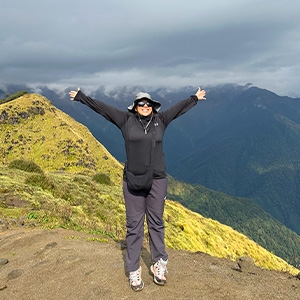Introduction and History
Mustang, a remote and enchanting region nestled in the north-central part of Nepal, stands as a testament to both natural grandeur and cultural richness. Bordered by the Annapurna and Dhaulagiri mountain ranges to the south and the vast Tibetan Plateau to the north, Mustang boasts a landscape that ranges from high-altitude deserts to lush river valleys.Mustang, a geographically diverse region, is divided into two main sections: Lower Mustang, with its charming villages like Jomsom, and Upper Mustang, a mystical and once-forbidden kingdom.
The Kali Gandaki River, flowing through the region, has carved the deepest gorge in the world, adding an extra layer of geographical intrigue to Mustang. The landscape is dotted with ancient monasteries, caves adorned with centuries-old paintings, and traditional mud-brick villages that echo the cultural influences of neighboring Tibet. The capital of Upper Mustang, Lo Manthang, with its historic palaces and walled city, exudes an aura of mystery and heritage.
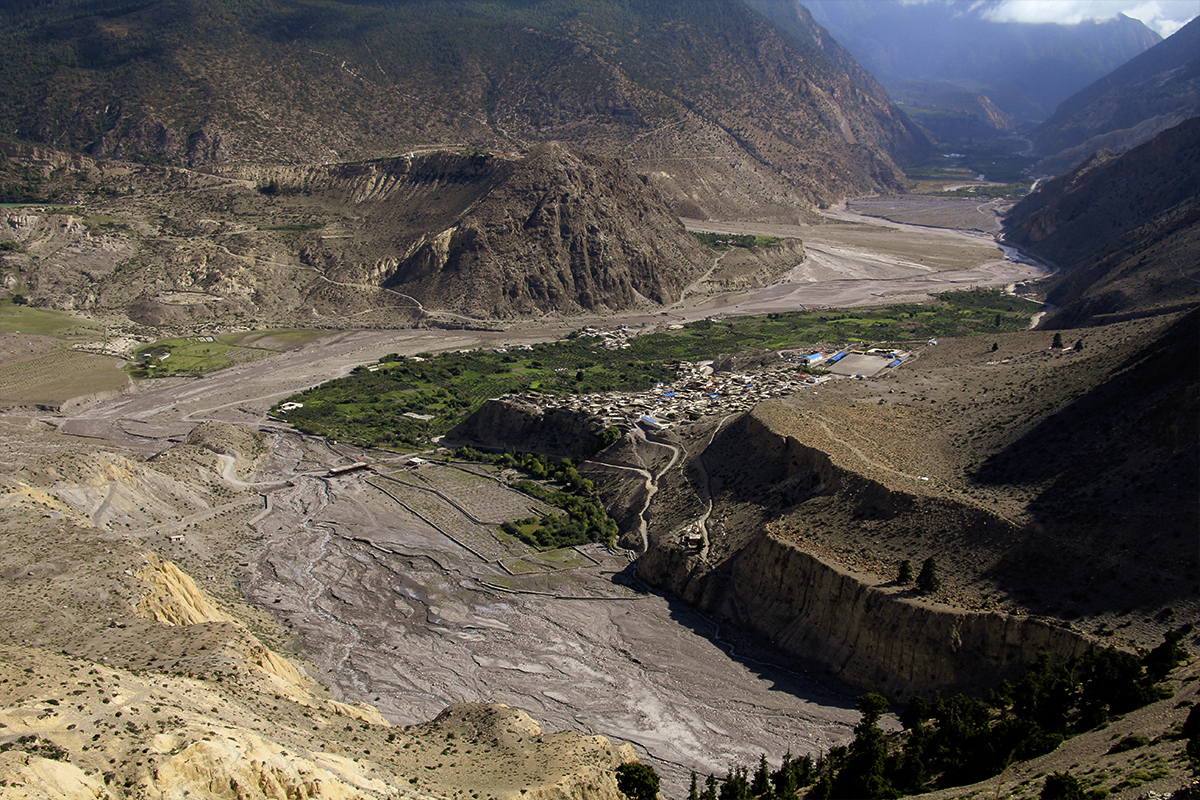
Mustang has long captured the imaginations of adventurers and cultural enthusiasts alike. Its history is intertwined with tales of trade along the ancient Salt Route, and the region was once closed to foreigners until 1992, contributing to its moniker as the "Forbidden Kingdom." Today, travelers can explore Mustang's unique landscapes, immerse themselves in its distinctive culture, and witness the convergence of Tibetan and Nepali traditions.
Whether you are trekking through the desert-like highlands, discovering ancient cave paintings, or participating in the vibrant Tiji Festival, a journey to Mustang offers an unparalleled blend of natural beauty and cultural authenticity. As Mustang gradually opens its doors to the world, it beckons intrepid explorers to experience a realm where time seems to have stood still, and the spirit of the Himalayas weaves a tapestry of wonders awaiting discovery.
Why Visit Mustang, Nepal?
Imagine walking through barren landscapes painted in hues of ochre, red, and gold, where the silence is broken only by the whispering winds and prayer flags fluttering. Mustang, often called the “Last Forbidden Kingdom,” combines nature, history, and spirituality like no other destination.
Here are a few compelling reasons to visit:
- Cultural Immersion: It indicated that Mustang still had its Tibetan flavor intact; that was good opportunity for viewing the old culture.
- Breathtaking Landscapes: Depending on the region all the landscapes ranging from desert like scenery to mountains, are something out of this world.
- Adventure Hub: Trekking, mountain biking, and jeep safaris through Mustang’s rugged terrain are interesting, challenging and unforgettable.
- Spiritual Haven: Sacred sites like the Muktinath Temple and ancient monasteries provide solace and serenity.
Weather and Climate in Mustang
Mustang, situated in the rain shadow of the Annapurna and Dhaulagiri mountain ranges, experiences a distinctive climate marked by its high altitude and arid conditions. Summers, from May to September, bring relatively warm daytime temperatures ranging from 15 to 25 °C, but nights can be cold, particularly at higher elevations. Winters, spanning November to February, are characterized by cold temperatures, with daytime highs between 5 and 15 °C and freezing nights. The region witnesses the influence of the monsoon season from June to September, with precipitation remaining comparatively low. Strong winds are a notable feature, especially in the afternoon, owing to the Kali Gandaki Valley's wind tunnel effect.
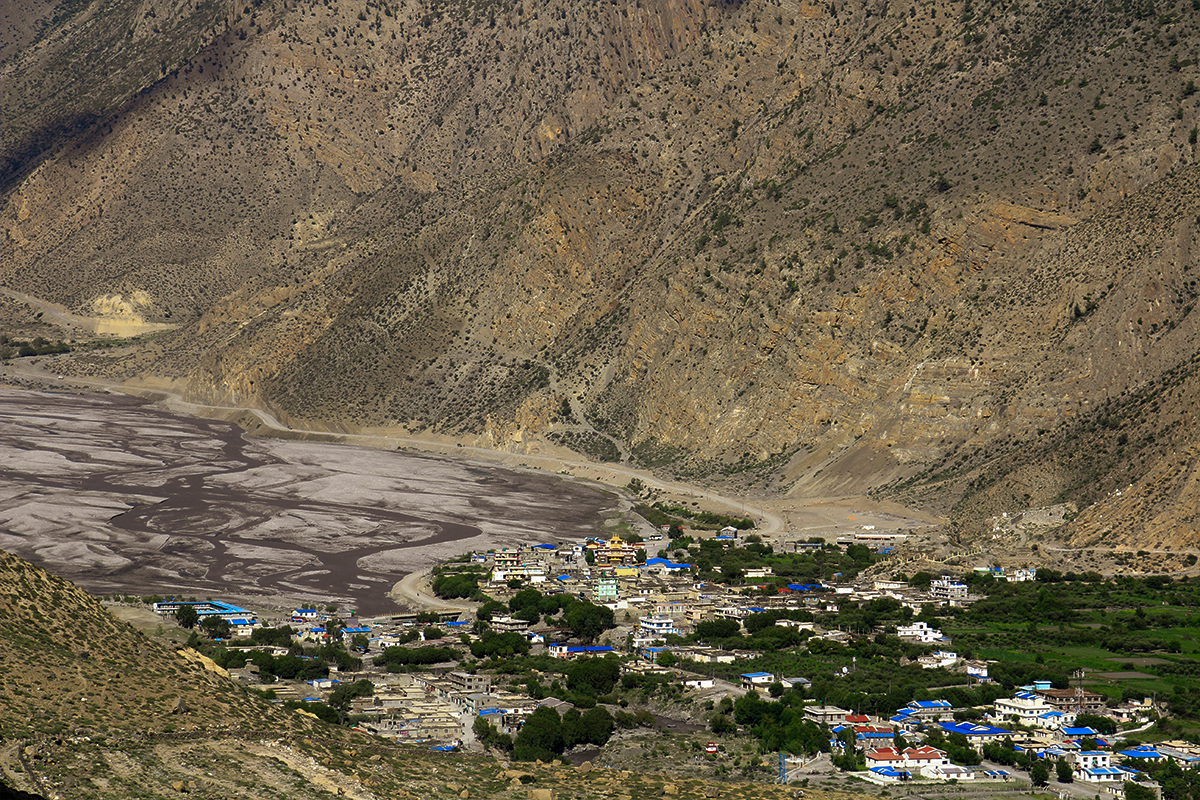
Best Time to Visit Mustang
The best seasons to visit Mustang for an ideal experience are during Spring (March to May) and Autumn (September to November). During spring, the weather is mild and pleasant, with blooming flowers adding vibrancy to the landscape. Autumn offers stable weather conditions with clear skies, making it ideal for trekking and other outdoor explorations. These seasons provide an optimal balance between favorable weather, stunning scenery, and cultural experiences, attracting trekkers and travelers keen on discovering the unique beauty of the Mustang region. It's advisable to plan visits during these times, considering the diverse terrain and altitude variations in Mustang.
Recommendation Read: Best Time to Trek in Nepal.
Normal Itinerary to reach Lower Mustang
Reaching Mustang might seem challenging, but the journey is part of the adventure. Here’s how to get there:
- Arrival in Kathmandu
- Kathmandu SIghtseeing
- Drive to Pokhara
- Fly to Jomsom, and Trek to Marpha/Kagbeni
- Day tour at Muktinath
- Trek back to Jomsom
- Flight from Jomsom to Kathmandu via Pokhara
- Departure Day
From Kathmandu:
- By Air: Fly to Pokhara (30 minutes) and then to Jomsom (15–20 minutes). Flights are weather-dependent but offer spectacular aerial views.
- By Road: Travel by bus or private jeep from Kathmandu to Pokhara (6–8 hours) and then to Jomsom (8–10 hours).
From Pokhara:
- A jeep safari or a two-wheeler ride to Mustang is a popular choice for adventure lovers.
Highlights of Mustang
- Undertake a sacred pilgrimage to Muktinath Temple in Lower Mustang, revered by both Hindus and Buddhists.
- Witness the majesty of the Kali Gandaki Gorge, one of the world's deepest, offering awe-inspiring natural views.
- Explore the enchanting village of Marpha, known for its apple orchards, white washed houses, and cobbled streets.
- Enjoy the serene atmosphere and take in the views of the surrounding mountains, making Jomsom a perfect resting point on your Mustang journey.
- Experience the serene allure of Dhumba Lake, a hidden gem nestled in the Mustang region.
- Wander through the captivating capital of Upper Mustang, Lo Manthang, where ancient palaces and monasteries tell tales of a rich cultural heritage.
- Immerse yourself in the Tibetan-influenced architecture, exploring traditional mud-brick houses that echo centuries of history.
- Traverse the barren landscapes and ancient cave dwellings as you embark on a trek through Upper Mustang.
- Discover the rich history of the region by visiting historic monasteries like Thubchen Gompa and Jampa Gompa along the way.
- Uncover the mystique of the "Forbidden Kingdom" as you realize its historical seclusion, closed to foreigners until 1992.
- Immerse yourself in the vibrant Tiji Festival in Lo Manthang, an annual celebration featuring traditional dances, rituals, and ceremonies.
- Marvel at the diverse terrains, from high-altitude deserts to lush valleys, offering breathtaking views of the Annapurna and Dhaulagiri mountain ranges.
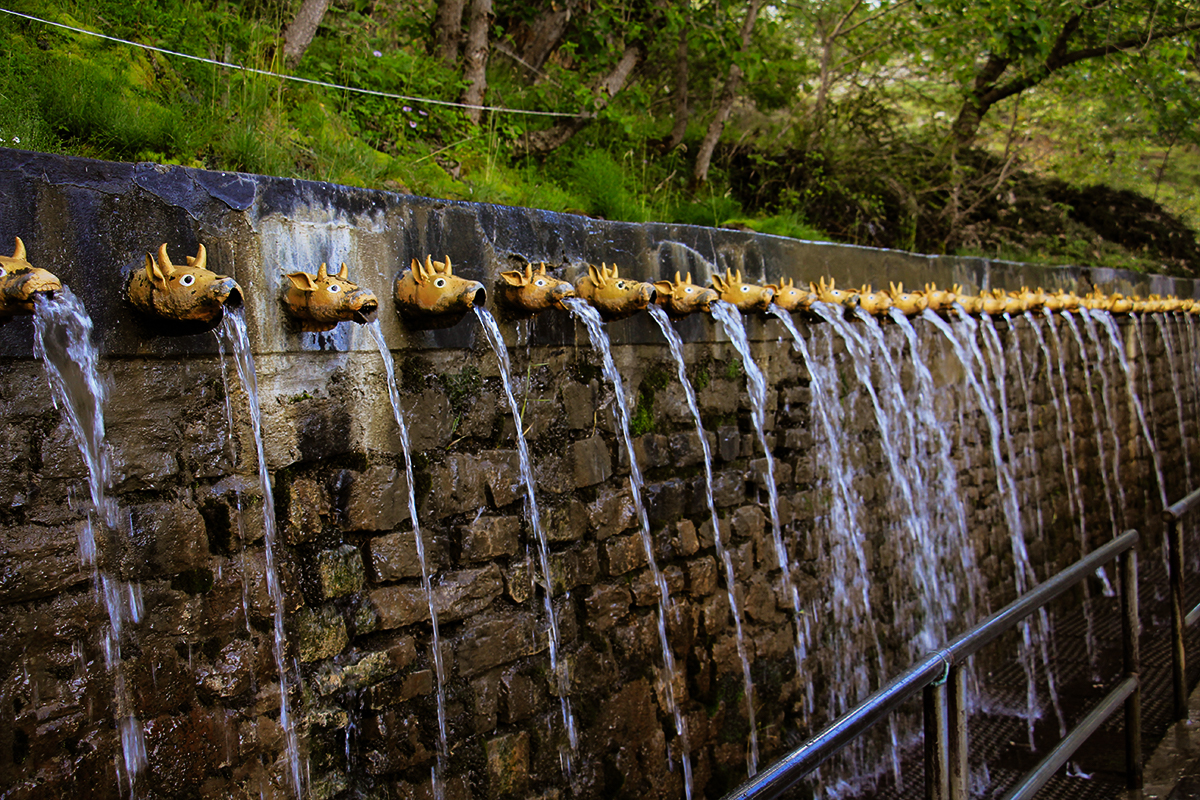
Best Places to Visit in Lower Mustang
Mustang, with its captivating landscapes and rich cultural heritage, offers a variety of places to explore. From sacred temples to picturesque villages, here are some notable places to visit in Mustang:
- Dhumba Lake: Situated at an altitude of 2,830 m above sea level, Dhumba is a heart shaped lake in Mustang. Surrounded by untouched natural beauty, the lake provides a peaceful setting for visitors seeking tranquility. The still water reflects the surrounding Dhaulagiri and Nilgiri mountain range, creating a picturesque scene that captivates those who venture to discover this serene haven in the heart of Mustang.
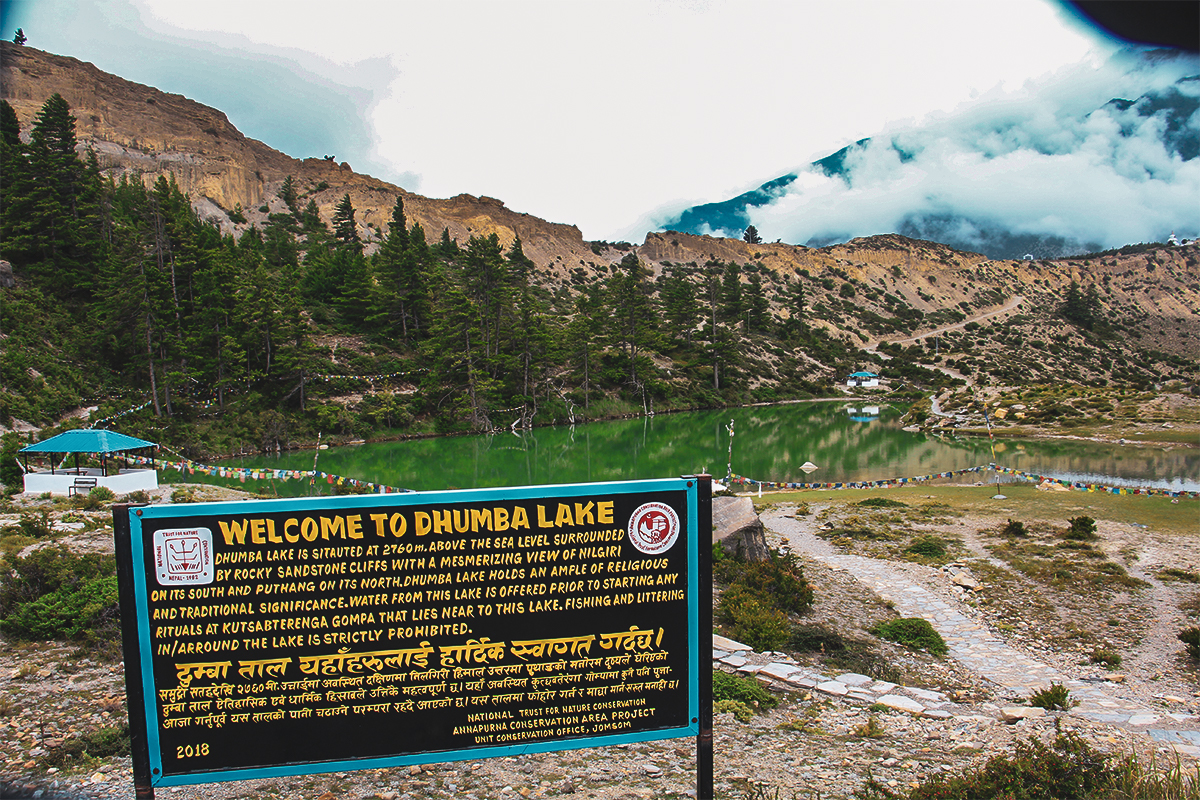
- Kagbeni: Nestled at the confluence of the Kali Gandaki and Mustang rivers, Kagbeni is a timeless village that beckons travelers with its traditional charm. Its narrow alleys wind through ancient structures, revealing a rich cultural tapestry. Kagbeni serves as the gateway to Upper Mustang, offering breathtaking views of the towering mountains. The village's ancient monasteries and unique architecture provide a glimpse into the region's cultural heritage, making it a captivating stop for those exploring the Mustang region.
- Jomsom: Jomsom, a bustling town in Lower Mustang, is a vibrant hub for trekkers and travelers at an altitude of 2,783 m. Framed by the Nilgiri and Dhaulagiri mountain ranges, Jomsom seamlessly blends traditional Thakali culture with modern amenities. As a central point for trekking into Upper Mustang, Jomsom welcomes visitors with its scenic beauty and lively atmosphere. The town's markets, monasteries, and surrounding landscapes make it a strategic and picturesque stop on the journey through Mustang.
- Muktinath Temple: Muktinath is a sacred hindu temple located at the highest elevation of 3,800 m above sea level in Nepal. Nestled in the mountainous terrain of Lower Mustang, Muktinath holds profound religious significance for Hindus and Buddhists alike. The temple complex, adorned with 108 water spouts and an eternal flame, draws pilgrims seeking spiritual solace. Muktinath's sacred atmosphere and panoramic views of the surrounding mountains make it a destination of reverence and awe, contributing to the cultural and religious diversity of Mustang.
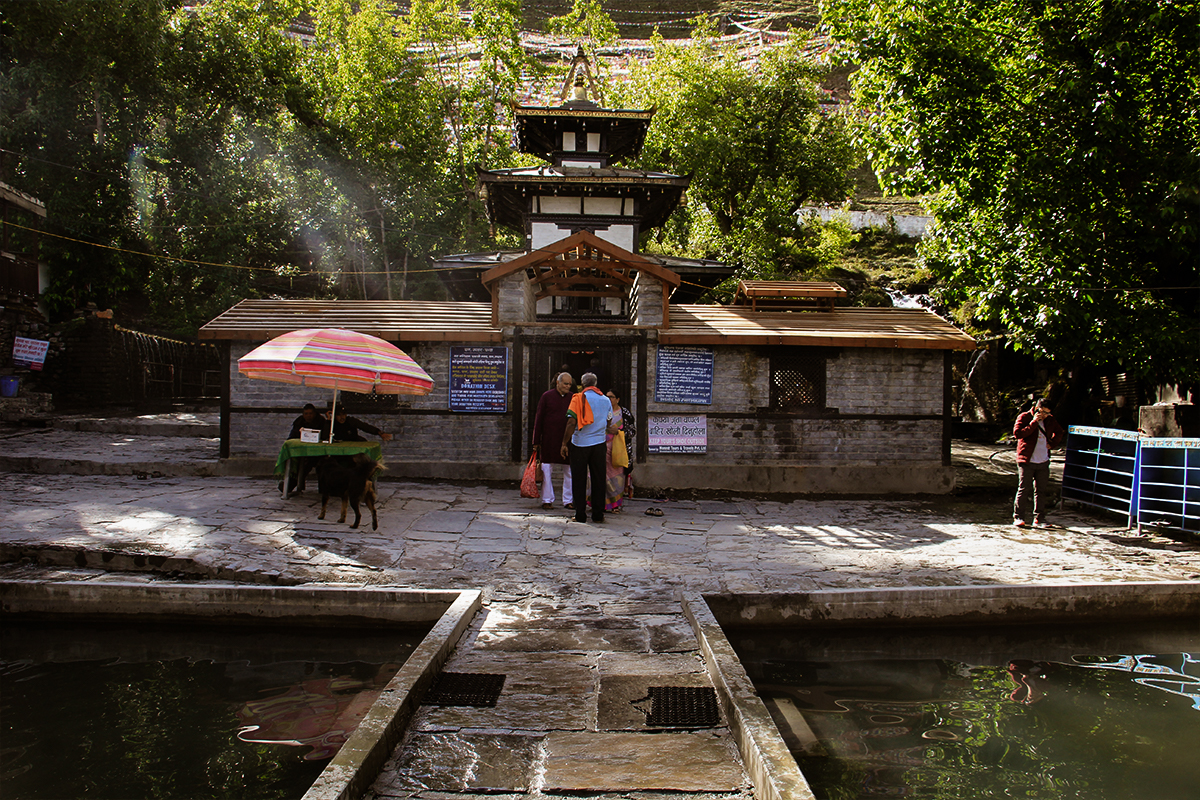
- Kali Gandaki River Gorge: Carving through the heart of Mustang, the Kali Gandaki Gorge stands as a natural marvel, separating the Annapurna and Dhaulagiri mountain ranges. As the world's deepest gorge, it offers trekkers a dramatic backdrop as they traverse the region. The gorge's towering cliffs and the roaring Kali Gandaki River create a breathtaking spectacle, showcasing the raw power of nature against the backdrop of the majestic Himalayas.
- Marpha: Marpha, a charming village in Lower Mustang, is renowned for its apple orchards and the production of Marpha brandy. White-washed houses line cobbled streets, creating an ambiance that transports visitors to a bygone era. Beyond its traditional appeal, Marpha offers a taste of local hospitality, making it a favorite among trekkers. The village's unique blend of culture, craftsmanship, and natural beauty makes it a must-visit destination in the Mustang region.
Accommodation in Mustang
Accommodation options in Mustang, Nepal, particularly in the towns and villages along popular trekking routes like the Annapurna Circuit and Upper Mustang, cater to the needs of trekkers and travelers. While the availability and types of accommodations can vary, here are some common options:
- Tea Houses or Guest Houses: Tea Houses are a prevalent form of accommodation along trekking routes in Mustang. These establishments provide basic amenities such as a bed, blankets, and meals. The level of comfort can vary, but teahouses offer a communal and sociable atmosphere, allowing travelers to interact with fellow trekkers.
- Lodges: Lodges in Mustang range from simple guesthouses to more comfortable accommodations with private rooms and attached bathrooms. These lodges may offer additional services such as hot showers, Wi-Fi, and dining facilities. The level of luxury varies, but lodges are generally a more comfortable option than teahouses.
- Homestays: In some villages, particularly in Lower Mustang, visitors may have the opportunity to stay in homestays. This option provides a more authentic cultural experience, allowing guests to live with local families, share meals, and gain insights into the daily life of the community.
- Camping: For those seeking a more immersive and adventurous experience, camping is an option in certain areas of Mustang. Trekking agencies and guides can arrange camping equipment and facilities for travelers who prefer a closer connection with nature.
- Hotels in Major Towns: In larger towns like Jomsom and Kagbeni, some hotels offer a wider range of amenities, including comfortable rooms, attached bathrooms, and dining services. These hotels cater to both trekkers and other visitors exploring the region.
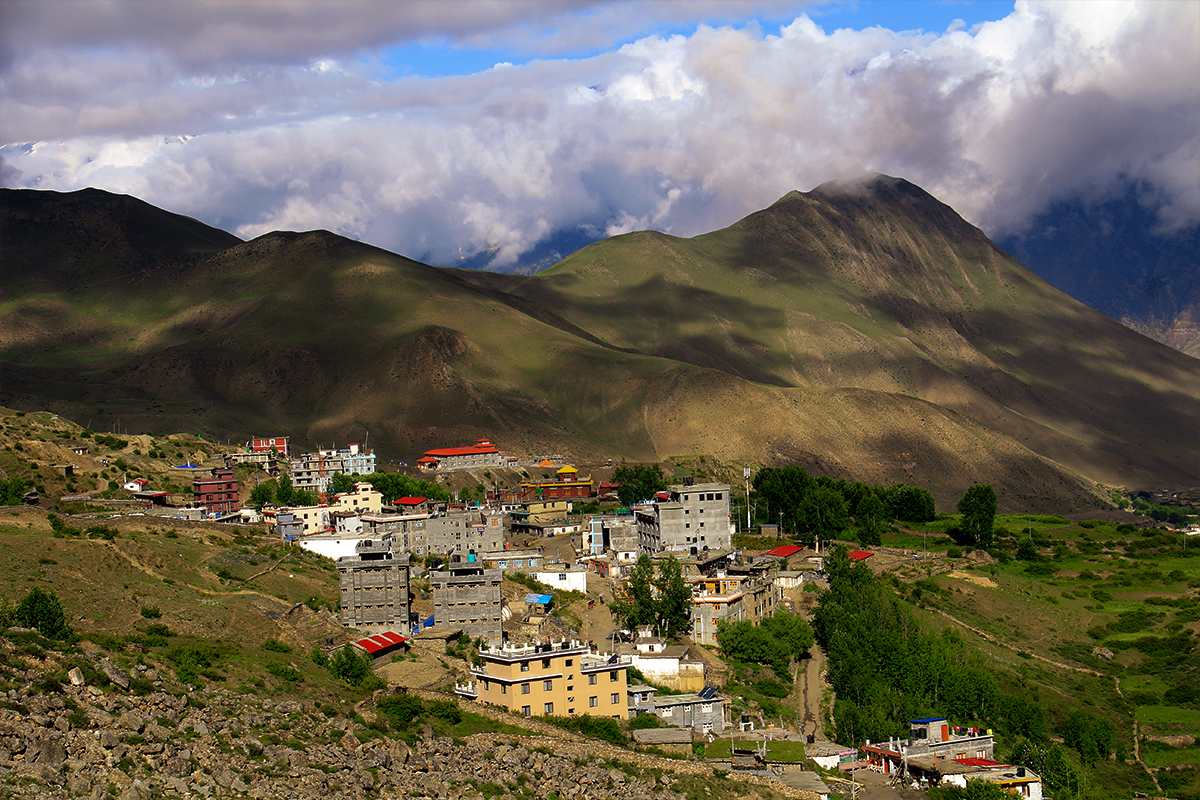
Permits and Entrance Fees
As Lower Mustang lies under the Annapurna Conservation Area, you will need the following permits:
- Annapurna Conservation Area Permit (ACAP): $30 per person
Whereas, If you are trekking or wish to extend your visit to Upper Mustang, you will need a:
- TIMS (in case you are trekking): $10 per person
- Restricted Area Permit: $500 for ten days per person. if the expedition lasts longer than 10 days, $50 per day (within the Upper Mustang area proper).
To know more about essential permits in Nepal, visit here.
Flora and Fauna in Mustang
Mustang, Nepal, showcases a diverse range of flora and fauna across its landscapes. Alpine vegetation, wildflowers, and thorny bushes characterize the region's plant life, while domestic animals like yaks and dzos are wildly common. The area is a haven for birdlife, including vultures and eagles. Though large mammals are limited due to the harsh terrain, snow leopards and Himalayan blue sheep are present. Conservation efforts are underway to protect Mustang's unique biodiversity, emphasizing responsible tourism practices. Travelers can enjoy the natural beauty while contributing to the preservation of this remarkable ecosystem.
Foods and Culture in Mustang
Mustang's unique cuisine is deeply influenced by Thakali traditions, and features staples like Dhido (buckwheat dough) and Thakali Dal Bhat. Local specialties include apple brandy and apple pies from Marpha. Tibetan momo dumplings are also popular Mustang.
The culture of Mustang is deeply rooted by Tibetan traditions and Tibetan Buddhism. Monasteries like Jampa Lhakhang and Thubchen Gompa are cultural landmarks in Mustang. The annual Tiji Festival in Upper Mustang showcases the vibrant religious traditions.
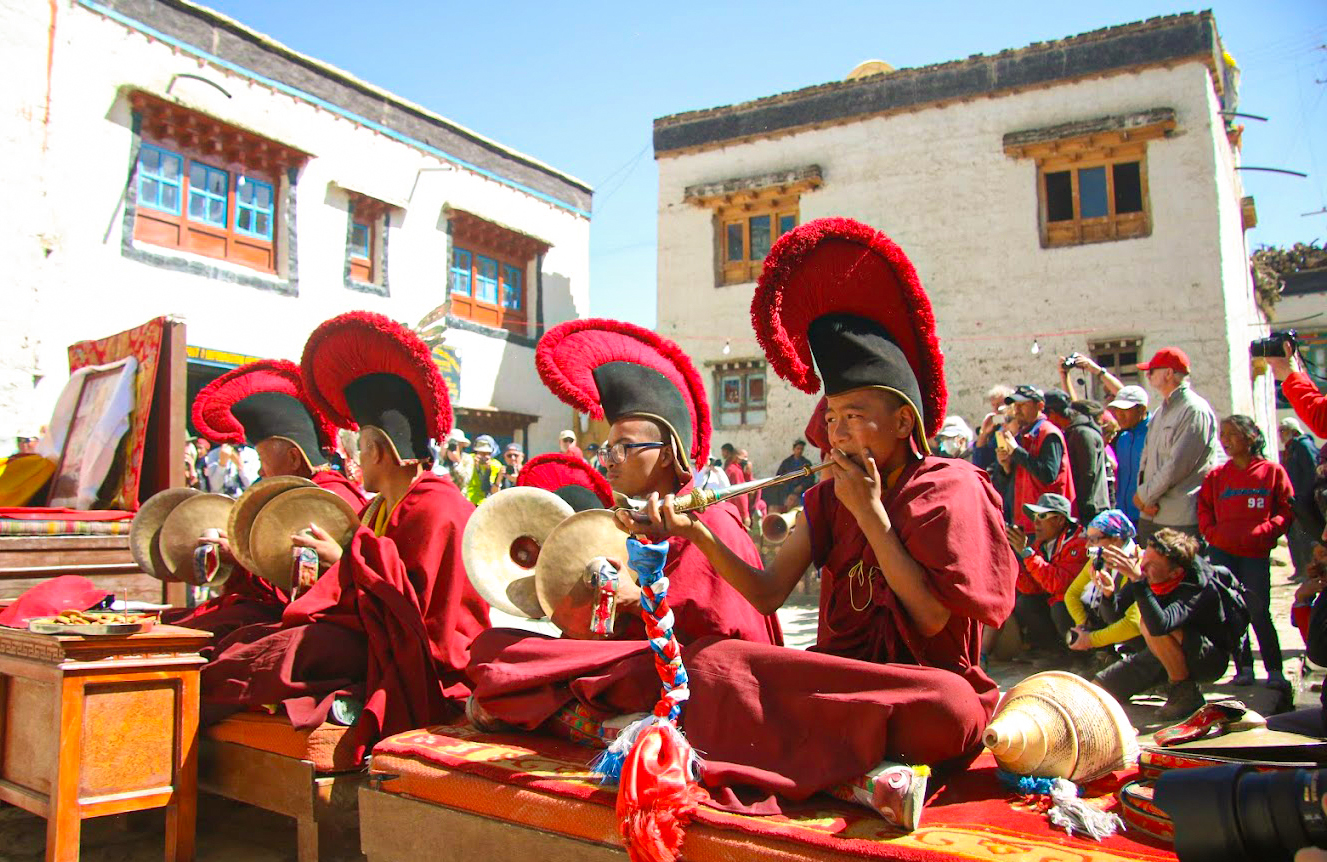
The unique Yak Dance is another traditional dance performed in the Mustang Region of Nepal. The Yak Dance is a significant cultural experience that reflects the local lifestyle and dependence on yaks, which are the integral parts of the economy in Mustang. During the Yak Dance, people dress up in the traditional costumes, disguising as a yak and mimic the movements and behaviors of yak. Yaks play a vital role in the livelihood of locals in Mustang. So, as a way to show gratitude towards yaks,yak dance is performed on the occasion of Tiji Festival. Whereas it also serves as the unique cultural attraction for tourists in Nepal.
The unique mud-brick architecture, ancient cave paintings, and traditional farming practices are integral to the cultural fabric. Festivals bring the community together, reflecting the warmth and hospitality of the Mustang.
Why is Mustang one of the Major Tourist Attractions in Nepal?
"Mustang, Nepal has recently been ranked 37th among the 52 must-visit places in 2024 by The New York Times." Here are some significant reasons why mustang is one of the major tourist attractions in Nepal:
- Until 1992, Mustang was a restricted area, often referred to as the "Forbidden Kingdom." This historical seclusion has added a layer of mystique to the region, attracting adventurous travelers seeking to explore a place that was off-limits to outsiders for many years.
- Mustang boasts diverse landscapes, ranging from high-altitude deserts to deep river valleys. The stunning backdrop of the Annapurna and Dhaulagiri mountain ranges, along with the Kali Gandaki Gorge (the world's deepest gorge), creates a visually captivating environment that appeals to nature lovers and trekkers.
- The Upper Mustang trek is a popular trekking route that takes visitors through picturesque villages, ancient monasteries, and breathtaking landscapes. The trek offers a unique blend of cultural immersion and natural beauty, making it a coveted experience for adventure enthusiasts.
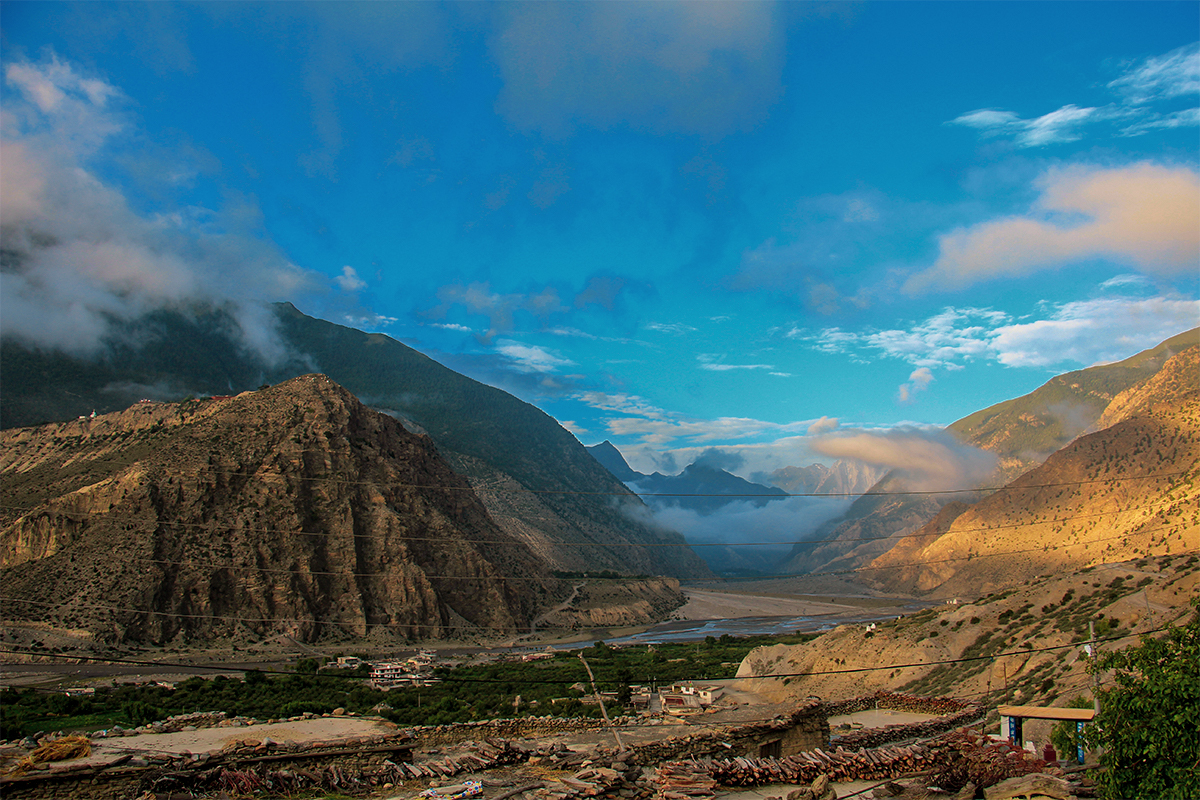
- The Tiji Festival, celebrated annually in Lo Manthang, is a major attraction. This vibrant and ancient festival features traditional dances, rituals, and ceremonies, providing visitors with an opportunity to witness the rich cultural and religious traditions of the region.
- Mustang played a crucial role in the ancient Salt Route trade between Tibet and India. The remnants of this historical trade route, along with ancient forts and palaces, contribute to Mustang's historical significance, drawing history enthusiasts and cultural explorers.
- Muktinath, located in Lower Mustang, is a significant pilgrimage site for both Hindus and Buddhists. Pilgrims visit Muktinath to seek spiritual solace, adding a religious dimension to the region's attractions.
- The people of Mustang, known as Mustangis, have worked diligently to preserve their unique Tibetan cultural identity. This commitment to cultural preservation adds authenticity to the visitor experience and fosters an appreciation for the region's distinct heritage.
Top Attractions in Mustang
1. Upper Mustang
- The Forbidden Kingdom: Upper Mustang was closed to foreigners until 1992 and still requires a special permit.
- Lo Manthang: This walled city is the cultural heart of Upper Mustang, boasting ancient monasteries, royal palaces, and intricate architecture.
2. Lower Mustang
- Kagbeni: A picturesque village where the Kali Gandaki River flows, offering a gateway to Upper Mustang.
- Marpha: Known as the “Apple Capital of Nepal,” Marpha offers delicious apple products and beautiful stone-paved streets.
3. Muktinath Temple
- A sacred site for Hindus and Buddhists, this temple is believed to cleanse all sins. The 108 water spouts and eternal flame are highlights.
4. Lo Manthang
- Once the capital of the Mustang kingdom, this town features a maze of narrow streets, ancient caves, and the majestic King’s Palace.
Conclusion
These key considerations will guide you in planning and enriching your trip in the mesmerizing region of Mustang, Nepal. Throughout your journey, be prepared to witness the vast landscapes, serene valleys, and diverse wildlife, promising an adventure that is both exhilarating and fulfilling. Moreover, the allure of Mustang extends beyond its borders, allowing you the option to seamlessly combine this trek with other renowned routes in the Annapurna region, such as the Upper Mustang Trek or Annapurna Circuit Trek should you wish to extend your exploration.
For those seeking more off-the-beaten-path adventures alongside Mustang, experience the Nar Phu Valley Trek stands as an intriguing alternative. These lesser-known treks promise unique perspectives and cultural encounters, adding depth to your Himalayan escapade.
Feel free to reach out to us anytime for inquiries specific to your next trip to Mustang. We believe that this guide will not only prepare you for the wonders of the Mustang trek but also inspire anticipation for the extraordinary experiences that await.
FAQs
What is the difference between Upper Mustang and Lower Mustang?
Lower Mustang is more accessible and has a mix of landscapes. Upper Mustang is remote, culturally Tibetan, and requires a special permit.
How long does it take to complete the Upper Mustang Trek?
The trek typically takes 14-17 days, depending on the itinerary and pace.
Is Mustang suitable for beginners in trekking?
Lower Mustang is beginner-friendly, while Upper Mustang requires moderate fitness due to higher altitudes and rugged terrain.
Are there ATMs in Mustang?
ATMs are scarce. Carry enough cash, especially if you plan to visit Upper Mustang.
Can I travel to Mustang during the monsoon?
Yes, Mustang lies in a rain shadow area, so it’s accessible even during monsoon.
What is the altitude of Mustang?
Mustang’s elevation ranges from 2,800 meters (Lower Mustang) to over 4,000 meters (Upper Mustang). Lo Manthang, the walled city, is at approximately 3,800 meters.
Is Mustang safe for solo travelers?
Yes, Mustang is generally safe for solo travelers. However, hiring a guide for Upper Mustang is advisable for navigation and cultural insights.
What kind of accommodation is available in Mustang?
Mustang offers a range of accommodations:
- Lower Mustang: Guesthouses, teahouses, and basic lodges.
- Upper Mustang: Fewer options, mostly basic teahouses. Advance booking is advised during peak seasons.
Can I visit Mustang with children?
Yes, but Lower Mustang is more suitable for families with children due to easier access and moderate altitudes. Upper Mustang can be challenging for young kids.
Is it possible to camp in Mustang?
Yes, camping is possible, especially in remote areas of Upper Mustang. However, it requires thorough planning, gear, and support from a trekking agency.

.jpg)








